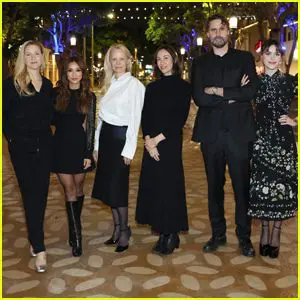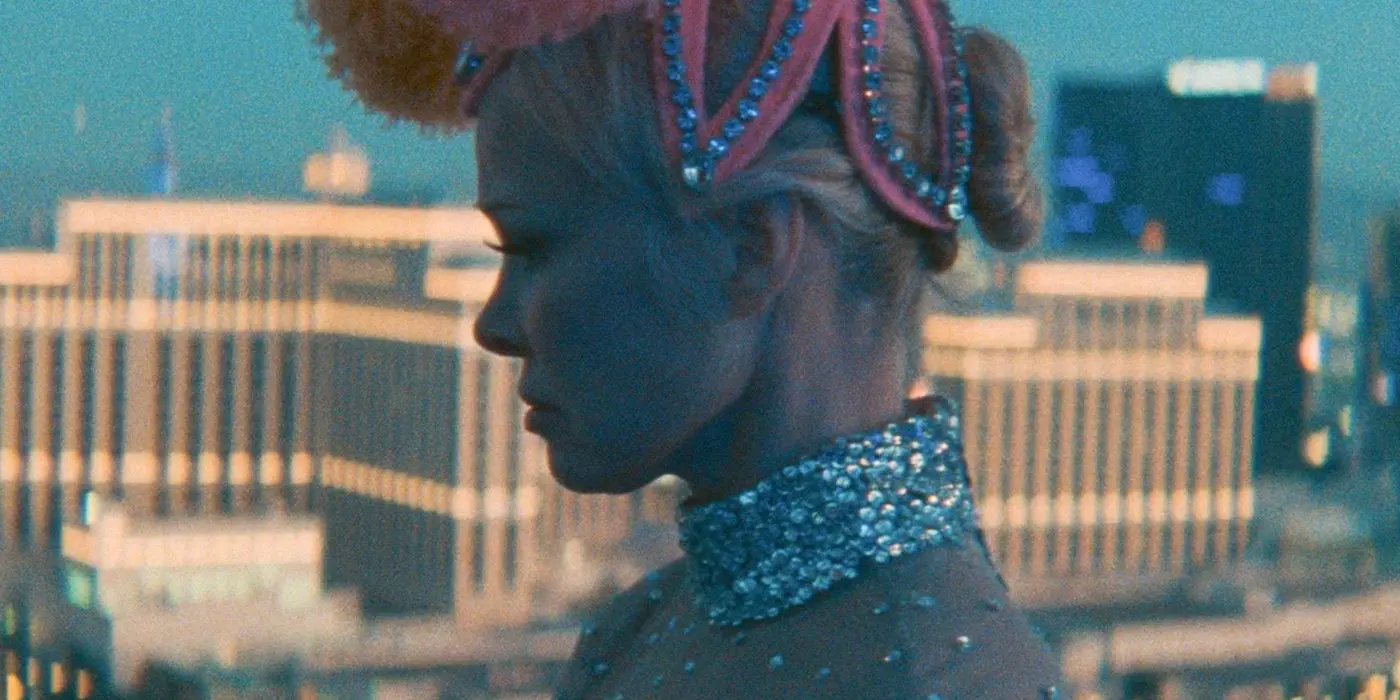In the world of film, the concept of beauty often takes center stage, with elaborate makeup, glamorous outfits, and flawless skin being the norm. However, the cast of ‘The Last Showgirl,’ including the iconic Pamela Anderson and Brenda Song, decided to take a refreshing detour by embracing a makeup-free approach. This choice, sparked by Anderson’s philosophy, not only challenged societal norms but also fostered a deeper connection among the cast members.
This unique decision to go without makeup while performing has transformed their onscreen personas, showcasing a raw and authentic version of femininity that many have come to admire. Brenda Song, known for her work in series like ‘The Suite Life of Zack & Cody’, shares her experience of working with Pamela Anderson and how her influence helped the cast feel comfortable taking the leap into a more natural appearance.
The Concept of Makeup-Free Filming
The concept of filming without makeup isn’t entirely new, yet it carries significant weight, especially within a film that targets a modern audience. Filming without makeup can create a sense of authenticity that resonates with viewers. It provokes thoughts on self-acceptance and challenges traditional beauty standards that prevail in Hollywood.
Brenda Song, who beautifully portrays dancer Mary-Anne in ‘The Last Showgirl,’ spoke about how being part of this project made her reflect on her previous experiences with makeup. Often, as actors, they feel pressured to look a certain way, leading to an array of insecurities. However, the decision made by Pamela Anderson to go makeup-free catalyzed an environment where all the actresses felt supported, resulting in more genuine performances.
Within this context, the cast pushed the boundaries of traditional beauty standards by deciding to portray their characters in a manner that reflected real life — unfiltered and real.
For a deeper dive into the film-making process of ‘The Last Showgirl,’ check out this insightful TikTok video showcasing behind-the-scenes moments.

Brenda Song’s Reflection on Makeup in Her Career
Brenda Song elaborated on her experiences growing up in the spotlight, often finding herself in situations where she had to prepare for the camera with layers of makeup. Reflecting on her past, she shared, “I just had two kids. I feel so insecure. And working with these women — who every day uplifted and supported me, made me feel beautiful — made me feel comfortable.” This vulnerability is something many women experience, especially those in the entertainment industry.
She highlighted how the environment created by Pamela and the other actresses allowed her to focus more on her performance without getting distracted by her physical appearance. The camaraderie among the actors fostered a culture of empowerment during filming.
Moreover, Brenda noted the liberating feeling of not having to worry about frequent touch-ups. When she stated, “There was something really freeing about not being worried every two seconds going, ‘Oh my God, this is the least amount of clothing that I’ve ever worn in my career,'” it became clear that the absence of makeup also translated to a sense of freedom regarding body image.
The Impact of Pamela Anderson’s Makeup-Free Philosophy
Pamela Anderson, a seasoned actress renowned for her glamorous roles, shifted the focus from her traditional beauty to a more grounded approach while promoting a makeup-free lifestyle. In a recent interview, she articulated her thoughts on why such a philosophy is essential, stating, “I wanted to just show how Shelly would be if she’s going to the grocery store. I just wanted it to be raw and real, and I was ready for that and prepared for that and excited about that.” This sentiment reflected a desire for authenticity that resonated deeply with her co-stars.
Her approach not only inspired Brenda but also encouraged the entire cast to rethink their perceptions of beauty. This paved the way for an unorthodox but rewarding exploration of self-image that was a breath of fresh air in the cinematic landscape. It also highlighted the importance of embracing one’s natural self, which in turn cultivated a team that felt more united and confident in their abilities to portray the characters authentically.
To see Pamela Anderson in her own words, you can refer to this insightful piece on her makeup-free journey: Newsweek article.
Empowerment Through Vulnerability
A significant thread woven into the fabric of ‘The Last Showgirl’ is the theme of empowerment through vulnerability. The act of going makeup-free on set transcends the superficial; it speaks volumes about self-acceptance, addressing insecurities, and fostering a supportive environment for all actors involved.
This idea is especially pertinent in today’s society, where the pressure for polished appearances is magnified by social media platforms. The courage shown by Brenda and her fellow cast members serves as a rallying cry for many to embrace their genuine selves.
Brenda articulately put this sentiment into perspective: “It doesn’t feel real,” when blasted with makeup. Here lies a counter-narrative to the over-glamorization often encountered within the cinema, as the film focuses on the beauty of imperfection.
Through this unique approach, the cast of ‘The Last Showgirl’ not only redefines beauty but also nurtures a sense of self-worth that encourages audiences to celebrate their own individuality.

Social Media’s Role in Shaping Beauty Standards
As social media dominates our everyday lives, it’s imperative to discuss its undeniable influence on beauty standards. Platforms flooded with filtered images often set unrealistic expectations, prompting actors and normal individuals alike to conform to a fabricated version of beauty.
In this context, the decision by the cast of ‘The Last Showgirl’ to forego makeup challenges not only movie conventions but also invites fans to reconsider their definitions of beauty. By stepping outside the conventional norms, the actresses highlight the importance of self-acceptance and promote a message that resonates widely with current societal trends toward body positivity.
Brenda Song’s personal revelations about insecurity reinforce an evolving dialogue: “When you didn’t see us in our showgirl makeup, we weren’t wearing any makeup. None at all.” This speaks directly to the societal pressures many face as they navigate their identities amidst the gaze of social media.
Interview snippets with Brenda and other cast members are available on platforms like Instagram where they candidly discuss their choices and experiences while filming.
Body Positivity Movement and ‘The Last Showgirl’
‘The Last Showgirl’ epitomizes the growing body positivity movement, further propelling the discussion surrounding beauty standards. With Brenda’s reflections combined with Pamela’s strong influence, the cast exemplifies both strength and vulnerability. They serve as role models for many, encouraging women and men alike to accept their bodies as they are.
The representation of beauty in media through a lens of reality gives rise to a new narrative: one that embraces authenticity and diversity. While traditionally portrayed beauty often marginalizes individuals that don’t fit societal standards, this film aims to pull together diverse representations of femininity.
This narrative is essential to not just the film, but also the larger culture – as these honest portrayals inspire others to be themselves, irrespective of appearances.
Behind-the-Scenes Insights from ‘The Last Showgirl’
In filmmaking, behind-the-scenes moments often reveal the heart and soul of a production, offering a glimpse into how actors connect with their roles. Interviews and casual conversations among the cast can uncover the truths that lie beneath the facade of glamour — in this case, the embracing of natural looks.
For Brenda Song and Pamela Anderson, their discussions were pivotal in shaping their characters and fostering an environment that felt supportive. Brenda recalled some of their exchanges, stating, “Pamela encouraged us in so many ways. She made it clear that we should feel comfortable in our own skin, regardless of how the world perceives us.” This sense of encouragement has left an indelible mark on Brenda’s approach to her craft and her own self-image.
For a sneak peek behind the lens, check out this YouTube video showcasing outtakes and behind-the-scenes banter from ‘The Last Showgirl’.

Emotional Dynamics Among Cast Members
Working alongside Pamela Anderson was not just about acting; it involved navigating emotional dynamics that would shape their performances. Brenda acknowledged how the atmosphere on set contributed significantly to their ability to portray vulnerable moments authentically. “Pamela being Pamela goes, ‘I’m not doing it. You guys shouldn’t do it either.'” This statement exemplified the unyielding spirit of solidarity present among the cast members.
This collective mindset resonated deeply, allowing each actress to shed personal insecurities, embracing their performances with a lighter heart. Moreover, this journey led to discussions beyond the set, as the camaraderie and trust built evolved into friendships that went beyond filming. The echoes of this shared experience have surely influenced their careers and personal growth.
The Legacy of ‘The Last Showgirl’
‘The Last Showgirl’ stands as a testament to the rapidly changing landscape of beauty and acceptance in Hollywood. By embracing their true selves, the cast encourages a shift towards a more humane view of beauty, one that cracks the façade of perfection and embraces imperfection. Through the inspirations from Pamela Anderson, Brenda Song, and others, their journey may forge new paths for future productions.
This legacy will enable a broader discourse surrounding femininity, vulnerability, and strength, thus inspiring future generations of actresses to honor their realities rather than conforming to manufactured standards of beauty.
A discussion on this powerful impact can be found in numerous articles, including one featured on AOL exploring the influence of Pamela’s philosophy on the cast of ‘The Last Showgirl’.
Hi, I’m Sarah, a 30-year-old journalist with a passion for storytelling and uncovering the truth. I strive to bring important issues to light and connect with my audience through compelling narratives.



